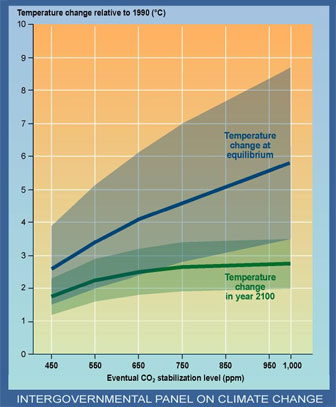Global warming to be more moderate than some expect
Rhett A. Butler, mongabay.com
April 19, 2006
A new study published in Nature says that climate change will be more moderate than some recent projections. Nevertheless, says lead author Gabriele C. Hegerl of Duke University, we can expect significant changes in the future.
“This still commits us to quite a bit of climate change, but it leaves the door open to avoiding the largest and most devastating consequences,” Dr. Hegerl told the Washington Post.
The study looked to refine “climate sensitivity”, or the change in global mean surface temperature in response to a doubling of atmospheric carbon dioxide levels. In 2001, the Intergovernmental Panel on Climate Change (IPCC) estimated that this value would likely fall in the range of 1.5 to 4.5 degrees Celsius (2.7-8°F), but other groups have projected much broader ranges. Currently carbon dioxide levels stand at 381 parts-per-million (ppm) or about 36 percent higher than pre-industrial levels. The IPPC projects that projects that atmospheric carbon dioxide levels could reach 450-550 ppm by 2050.
The new research, based on proxy data from the past 700 years — including carbon dioxide levels measured in sea ice, temperature data derived from tree rings, and the cooling impact of volcanic eruptions — suggests that climate sensitivity is likely to be in the moderate range of current projections. The paper indicates a 90 percent probability that a doubling of carbon dioxide levels will result in temperature increases of between 1.5 and 6.2 degrees and only a 5 percent chance that global temperatures will climb more than 6°C (10.8°F).
Nevertheless an increase anywhere near that magnitude would likely have a devastating impact on the polar ice caps, sea levels, worldwide precipitation patterns, and global biodiversity. For example, Ove Hoegh-Guldberg, head of the University of Queensland’s Center for Marine Studies, has estimated that a mere 1.5°C increase in ocean temperatures could kill 95 percent of the Great Barrier Reef’s living coral, while last week, researchers warned that walrus and polar bears are threatened by melting ice in the Arctic.

|
The Nature paper comes days after the Environmental Protection Agency released figures showing U.S. greenhouse gas emissions hit record levels in 2004. Greenhouse gases, which result from fossil fuel combustion and deforestation, are seen by most scientists as the principle force behind global warming
Hegerl disputed claims by some studies that preindustrial temperatures fluctuated very little until the past century, and have risen sharply since.
“Our reconstruction supports a lot of variability in the past, as well as an upward trend in the 20th century,” she said. Before the modern era, the record “shows a climate reacting then and now to a variety of ‘external forcing.'”
“External forcing” includes all outside influences that can affect climate, explained Hegerl. Understanding how past temperatures responded to such forcings — before the impact of industrial emissions of carbon dioxide and other heat-trapping gases — helps scientists predict future forcings by greenhouse gases, she added.
Of these forcings, the most important may be volcanic eruptions. “You can see downturns in temperature exactly where you see volcanic eruptions,” said Hegerl.
End note: Hegerl’s co-authors include Thomas Crowley of Duke University; William Hyde of the University of Toronto, and David Frame, of the University of Oxford.
RELATED ARTICLES
 IPCC projections reflecting the uncertainty of future climate. |
US Greenhouse gas emissions hit record in 2004 April 19, 2006
Figures released Monday show that US greenhouse gas emissions hit a record in 2004, rising 1.7 percent over 2003. The increase, equivalent to a rise of 115 million tons of carbon dioxide, was the largest annual increase since 2000.
Record one-year increase in carbon dioxide levels March 13, 2006
A new report evaluating air pollution trends at the nation’s 100 largest electric power producers shows that emissions of sulfur dioxide (SO2) and nitrogen oxides (NOx) have fallen markedly in recent years, but carbon dioxide (CO2) emissions increased and will likely spike in coming years.
2005 was the warmest year on record January 24, 2006
A new study by NASA indicates that 2005 was the warmest year in at least a century, surpassing 1998. According to their data, the five warmest years over the last century have occurred since 1997: 2005, then 1998, 2002, 2003 and 2004.
Carbon dioxide level highest in 650000 years November 24, 2005
Carbon dioxide levels are now 27 percent higher than at any point in the last 650,000 years, according to research into Antarctic ice cores published on Thursday in Science.
This article used information from the Washington Post, Duke University, and the EPA.